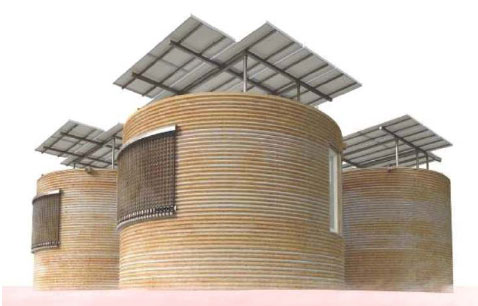Thermablok® News Stories
Thermablok® Aerogel News Stories
Cornell University Chooses Thermablok® to insulate its Solar Decathlon “Silo House”
 The 800 square-foot eco-friendly home will be on display at the New York State Fair in Syracuse Aug.27 – Sept.9
The 800 square-foot eco-friendly home will be on display at the New York State Fair in Syracuse Aug.27 – Sept.9Cornell University students are preparing to unveil their eco-friendly “Silo House” at the New York State Fair August 27-September 9, just weeks before moving it to Washington DC for the 2009 Solar Decathlon. The Solar Decathlon is a prestigious international competition sponsored by the U.S.
Department of Energy that challenges 20 college and university teams from around the world to design, build, and operate the most aesthetic, energy-efficient, livable model home possible. These new home entries will be the absolute cutting edge in energy conservation and generation.
Designed by Cornell University architectural student Irina Chernyakova, the Silo House style combines sustainable modular design with a unique assembly of geometric elements.
According to the Cornell Solar Decathlon website, Chernyakova’s intention was to emulate the colloquial architecture of the upstate New York landscape, combining traditional and original designs to create a complete living space.
Considering the challenges faced by these students to design and build a truly energy-efficient house adaptable to the rural New York State climate, Thermablok® became the state-of-the-art insulation of choice for the project team due mainly to the structure’s all-steel framework. Thermablok’s aerogel nano-technology, developed in conjunction with NASA, is the highest insulating material known to exist.
It is estimated that 40-percent of our energy is used controlling the temperature in buildings alone. More than 30-percent of this energy escapes from the building primarily through conventionally insulated walls and windows in a process termed thermal bridging.
Virtually all new construction uses metal stud walls. In such a wall approximately 62-percent of its thermal leakage occurs through the cavity section and 38-percent through the metal stud in the thermal bridging process. So, regardless of the improvements in the installation, in the cavity there is still a 38-percent or greater leakage through the metal stud. If a foam insulation is used in the wall instead of fiberglass, the thermal bridging through the metal stud becomes even greater, as it dissipates no heat into the cavity.
Tests by the US Department of Energy’s Oak Ridge and JM laboratories indicated this resulted in an R value increase of more than 40-percent.
“We’re really happy about being able to install the Thermablok in this house, especially since there is a lot of steel in the framework,” said Lewis King, a second year engineering student at Cornell who has been a team member since January, 2008. “It’s the best insulator we could have used, it’s a perfect fit.
The Cornell Solar Decathlon team is composed of more than 150 students from undergraduate and graduate colleges across campus including the Colleges of Engineering, Architecture, Art & Planning, Hotel Administration, Industrial and Labor Relations, Human Ecology, Agricultural and Life Sciences, Arts and Sciences, and the Johnson Graduate School of Management.
Unlike the other universities, who focus on architecture and engineering students for their projects, Team Cornell opted to involve students from all seven colleges in an effort to bring a broader pool talent and expertise to the competition.
“For me personally, I find it comparable to starting a business team,” King says. “Our team involves someone from all seven colleges. We’re the first team in this competition’s history to involve the entire school.”
After the New York State Fair winds down, Cornell team members will dismantle the Silo house and transport it to for Washington DC to reassemble it for the Solar Decathlon, which runs October 9-13 & 15-18, 2009. The Solar Decathlon is a biannual event started in 2002 in which university students from all over the world compete in 10 contests to determine which team designed, constructed, and operated the most attractive and energy-efficient home powered solely by the sun.
After two years of planning, designing and building, teams converge on the nation’s capital to share with the public what they learned about the latest solar energy and energy efficiency technologies. Students are scored in 10 different categories: architecture, engineering, market viability, communications, comfort, appliances, hot water, lighting, energy balance, and transportation. Each house must produce enough electricity and hot water to perform all the functions of a home and to power an electric car.
Thermablok is virtually weightless, 100-percent recyclable, hydrophobic (will not combine with water) and consists of more than 95-percent air, making it easy and inexpensive to ship, store and install. It is Class “A” fire rated, Cradle to Cradle Silver certified and will not age.
Thermablok and its parent company, Acoustiblok Inc., an international acoustical research company, are proud to sponsor environmentally important projects in the worldwide community such as the Solar Decathlon.

